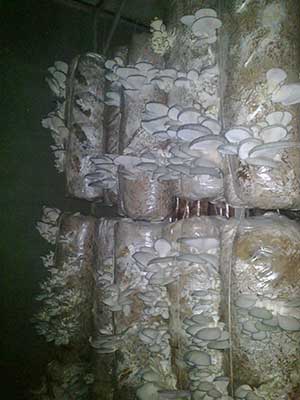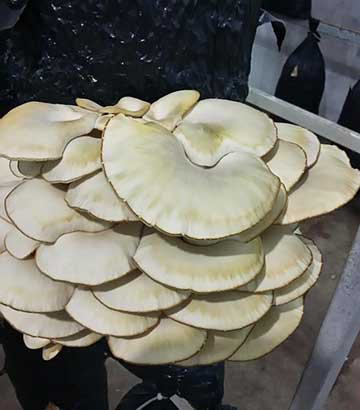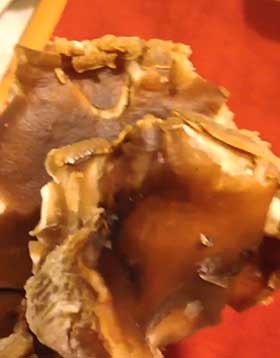
In this article, I’ll share what I’ve learned from years of working with different strains, conditions, and mistakes — including my own first experience, which I’ll show you with a photo.
Growing oyster mushrooms requires three interconnected systems:
▶️humidification (moisture control in the grow room),
▶️heating,
▶️ventilation.
And if you're growing in summer — or live in a very warm climate — you’ll also need a cooling system.
This could be a chiller, evaporative panels, or even a simple cold water spray setup, depending on your resources.
Contents of the article
Most strains today no longer need a cold shock to start fruiting.
So if someone tells you that you have to cold shock your blocks, check the information from your spawn supplier first. For modern strains, it’s usually not needed.
If you’re buying spawn from a professional producer, they should provide a cultivation passport — a one-page document with basic recommendations: incubation and fruiting temperatures, humidity, and CO₂ levels for each stage.
If they don’t — that’s a red flag.
There is no one "ideal" temperature for oyster mushrooms.
📌It depends on the strain you are using.
But here’s a general guide:
▶️Winter strains: 8–12°C (46.4–53.6°F)
▶️Universal strains: 14–17°C (57.2–62.6°F)
▶️Summer strains: 16–25°C (60.8–77°F)
Whatever the season, your grow room needs to maintain a stable temperature within the right range for your specific strain.
When temperature and other conditions are right, mushrooms ripen faster, the clusters are dense and fleshy, and the yield is higher.
In the photo below — my very first mushrooms, grown back in 2007 in an abandoned house.

I was proud of them!
But now I can clearly see: they grew in dry air, with only 20% fresh air circulation. The caps are thin, and the clusters were very light.
Some tropical or heat-tolerant strains can fruit well even at 22–25°C (71.6–77°F), especially if you already have experience adjusting humidity for different conditions.
Keep in mind, though — at higher temperatures, clusters are usually lighter, caps thinner, and their color tends to be pale gray or almost white.
Oyster mushrooms will still grow at 5–7°C (41–44.6°F), but very slowly. It’s also much harder to maintain good humidity and air exchange.
If your bags are spaced far apart — on racks or even on the floor — you can sometimes get away with simply turning on the exhaust fan to let in small amounts of fresh air.
💡But growth stops completely at 0°C (32°F) and below.
In winter, clusters may freeze and restart growth after defrosting — but primordia often die.
Maintaining good conditions in cold weather is tricky — not just because heating is expensive, but because cold air contains almost no moisture.
For example, at -20°C (-4°F), there’s practically zero humidity in the incoming air.
💡That’s why I recommend working with 60–70% recirculation in winter.
It saves heat and helps keep humidity at acceptable levels.
📌If you're not sure what air recirculation means or how it works, I explain it in more detail in this article about ventilation.
Maintaining proper humidity is key to achieving good yields.
Oyster mushrooms are made up of around 95% water — both their stems and caps.
💡Even small fluctuations in humidity, or excess/lack of moisture, can cause primordia to die or lead to deformities in older fruiting bodies.
What humidity is good for mushrooms?
A range of 82–89% is generally good for normal mushroom development. The exact level depends on the strain you're using and the temperature in the grow room.
Read below 👇
Usually — no. And here’s why:
Ideally, the water in your humidification system should be close to the room’s air temperature — typically around 55–63°F (13–17°C).
Most tap water already falls within this range.
If your water happens to be very cold (below 50°F / 10°C), it may help to warm it slightly. But I don’t recommend heating it above room temperature.
Why? Because when warm water mist mixes with colder air, it can lead to unpredictable condensation.
This moisture may collect on your mushrooms — especially on pinheads — and cause problems.
Fungi don’t adapt to dry air the way higher plants can. Their cells are poorly differentiated, so they can’t continue growing if the environment is too dry.
💡If humidity drops below 78%, primordia often fail to form.
If it rises periodically, you might still get a few scattered mushrooms, but the rest will remain underdeveloped or dry up.
If humidity falls below 65%, the perforation dries out, and the mycelium dies around the hole.
A plug of dead mycelium forms, and the block won’t fruit until the slot becomes wet again — even if the overall climate is fine.
Once the perforation rehydrates well, new hyphae can reach the surface and form primordia.
When air humidity stays below 80%, clusters become light, dull, and pale. They lose their healthy sheen and look almost bleached.

They turn yellow and develop a dry brown rim if the airflow is too strong. The cap becomes as thin as paper.
This can happen even with a normal flow rate (8–9 m/sec) if the duct nozzle is pointed directly at the mushrooms.
In that case, moisture gets blown off the caps, even though the room’s humidity is fine.
When this happens, the mushroom forms gills but no inner flesh — it rushes to produce spores as a survival response.
If humidity is just slightly low, the mushrooms may still look marketable, but the cap edges may curl down and become wavy.
📌You can read more about these types of issues in my article: "Diseases of oyster mushroom"
It depends on many things:
▶️strain
▶️temperature
▶️ventilation system
▶️amount of recirculation
The best way to get it right is through observation and experience.
From my own practice:

✅Clusters often suffer from condensation damage when the temperature drops below 8°C (46.4°F).
✅The colder the air, the slower the mushrooms grow — and the less moisture they need from the air.
✅In very cold rooms, excessive humidity becomes dangerous.
Some varieties, like Pleurotus pulmonarius, tolerate very high humidity (up to 95–97%) and still form clusters — even in fog.
But under these conditions, the mushrooms become brittle, the gills grow thick and sponge-like (as in the photo), and water is released when pressing on the cap.
You’ll also notice the gills stretching and merging, forming a net-like structure.
In general, the warmer the grow room, the higher the humidity should be.
To estimate your target, you can use this guideline:
✅At 10°C (50°F), keep humidity around 83%.
✅For every degree above that, increase humidity by 1%.
So:
11°C → 84%
12°C → 85%
...and so on.
But don’t treat this rule as strict. The best option is always to request the strain’s cultivation passport from your spawn supplier.
If you want consistently high yields, you need stable, well-controlled conditions.
Moisture is one of the key components of your growing room environment — treat it like an investment.
